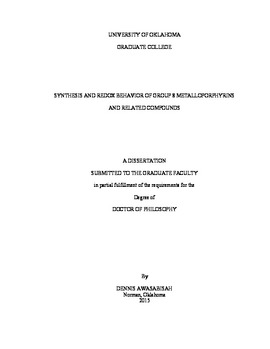| dc.description.abstract | This dissertation describes the Chemistry of Group 8 Metalloporphyrins and related compounds. Chapter one describes linkage isomerization in NOx-coordinated metal complexes with emphasis on Group 8 metals, and part of this work was published in the series Advances in Inorganic Chemistry, Vol. 47. As already noted in the published work, the binding of small molecules such as nitric oxide (NO) to metals often imparts varied chemistry to the small molecules. Such chemistry is dependent on the coordination mode of the small molecule ligands, as the coordination mode affects the electronic distributions along the ligand atoms. In chapter one, the current knowledge of the linkage isomerization of NOx ligands in metal complexes is outlined for both non-porphyrin and porphyrin systems. The modes of preparation and detection, and speculation on the consequences of such linkage isomerization on the resultant chemistry, are presented.
Chapter 2 describes the synthesis and redox behavior of the complexes (por)Ru(NO)(OR) (por = porphyrin, OR = alkoxide, carboxylate). These systems serve as potential structural models for the NO-inhibited heme enzyme catalase that contain (por)Fe(OR) active sites. The (por)Ru(NO)(OR) compounds were characterized by IR and 1H NMR spectroscopy, and by X-ray crystallography. The X-ray crystallographic data reveal that the RuNO linkages are linear for these formally {RuNO}6 species; for comparison, the (por)Ru(NO)Cl (por = OEP,T(p-OMe)PP) compounds also have linear RuNO bonds, whereas the related compounds (T(p-OMe)PP)Ru(NO)Et (∠RuNO = 153.4(5)°) and (TTP)Ru(NO)(C6H4F-p) (∠RuNO = 152°) have bent RuNO moieties. The alkyl/aryl ligands in the latter compounds are strongly σ donating to the metal with concomitant bending of their trans RuNO units. Cyclic voltammetry and IR spectroelectrochemistry reveal reversible oxidations centered on the porphyrin rings in most of these (por)Ru(NO)(OR) complexes, a finding that supports the generation of porphyrin π-radical cations in oxidized natural (por)M(NO)(O-ligand) systems. The electrochemical reductions result in the eventual dissociation of the axial O-ligands with concomitant generation of the putative and unstable (por)Ru(NO) byproducts.
In Chapter 3, I explore the relationship between the stereochemistry and spin-states of a set of (por)Fe(OR) (R = aryl, alkyl) complexes using X-ray crystallography and solution measurements. The magnetic susceptibility data obtained by the Evans method show that most of these complexes are mainly high-spin species. X-ray crystal structures of these five-coordinate complexes show that the compounds are square pyramidal with axial O-bound ligands. The Fe−O bond lengths are ~1.9 Å and the Fe−N bonds are ~2 Å. The iron atoms of these compounds are displaced >0.3 Å above the 24-porphyrin atom mean planes. The crystallographic data support the high-spin properties observed in solution for these complexes. In some of the complexes, however, the X-ray crystal structures show severe distortion of the porphyrin macrocycles. Magnetic susceptibility measurements of those distorted porphyrin macrocycles show that they exhibit admixed spin-state properties in solution. The CV and IR spectroelectrochemistry of representative examples of these complexes show irreversible oxidations and reversible reductions. Furthermore, some of the five coordinate (por)Fe(O-aryl) and (por)Fe(O-alkyl) complexes in the powdered form react with NO to generate the six-coordinate (por)Fe(NO)(OR) compounds. A comparison of the IR data of the five-coordinate (por)Fe(OR) and six-coordinate (por)Fe(NO)(OR) shows a trans influence of NO on the axial ligands, and this has been confirmed by DFT calculations. Finally, IR spectroelectrochemical experiments of a representative six-coordinate compound suggest a porphyrin-centered oxidation with electroreduction being accompanied by NO release.
In Chapter 4, I report on the preparation and characterization of some iridium phosphine complexes and I examine the reactivity of such complexes with small molecules. I present the reactivity of these complexes with alkyl nitrites leading to the formation of the related M{N(=O)OR} complexes of relevance to bioinorganic chemists. | en_US |
